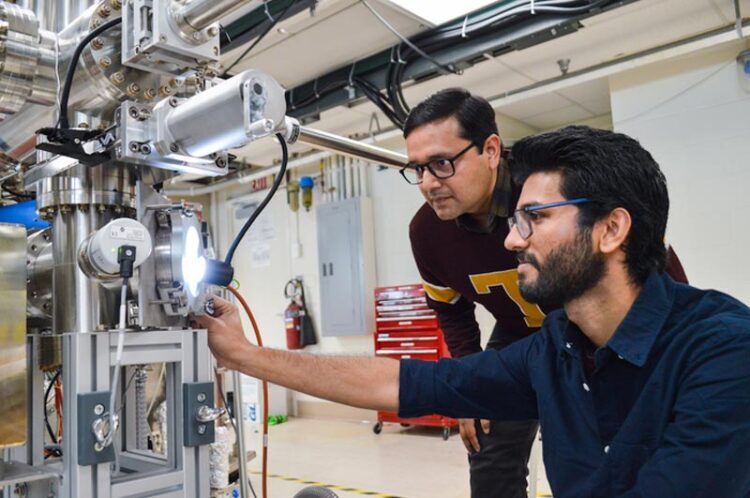Stretching metals at the atomic level

University of Minnesota chemical engineering and materials science researchers have developed a breakthrough method for creating high-quality metal oxide films that are important for next generation applications like quantum computing and microelectronics.
Credit: Olivia Hultgren, University of Minnesota
… allows researchers to create important materials for quantum, electronic, and spintronic applications.
New technique paves the way for easy oxidation of historically “stubborn” metals.
A University of Minnesota Twin Cities-led team has developed a first-of-its-kind, breakthrough method that makes it easier to create high-quality metal oxide thin films out of “stubborn” metals that have historically been difficult to synthesize in an atomically precise manner. This research paves the way for scientists to develop better materials for various next-generation applications including quantum computing, microelectronics, sensors, and energy catalysis.
The researchers’ paper is published in Nature Nanotechnology, a peer-reviewed, scientific journal run by Nature Publishing Group.
“This is truly remarkable discovery, as it unveils an unparalleled and simple way for navigating material synthesis at the atomic scale by harnessing the power of epitaxial strain,” said Bharat Jalan, senior author on the paper and a professor and Shell Chair in the University of Minnesota Department of Chemical Engineering and Materials Science. “This breakthrough represents a significant advancement with far-reaching implications in a broad range of fields. Not only does it provide a means to achieve atomically-precise synthesis of quantum materials, but it also holds immense potential for controlling oxidation-reduction pathways in various applications, including catalysis and chemical reactions occurring in batteries or fuel cells.”
“Stubborn” metals oxides, such as those based on ruthenium or iridium, play a crucial role in numerous applications in quantum information sciences and electronics. However, converting them into thin films has been a challenge for researchers due to the inherent difficulties in oxidizing metals using high-vacuum processes.
The fabrication of these materials has perplexed materials scientists for decades. While some researchers have successfully achieved oxidation, the methods used thus far have been costly, unsafe, or have resulted in poor material quality.
The University of Minnesota researchers’ solution? Give it a stretch.
While attempting to synthesize metal oxides using conventional molecular beam epitaxy, a low-energy technique that generates single layers of material in an ultra-high vacuum chamber, the researchers stumbled upon a groundbreaking revelation. They found that incorporating a concept called “epitaxial strain”—effectively stretching the metals at the atomic level—significantly simplifies the oxidation process of these stubborn metals.
“This enables the creation of technologically important metal oxides out of stubborn metals in ultra-high vacuum atmospheres, which has been a longstanding problem,” said Sreejith Nair, first author of the paper and a University of Minnesota chemical engineering Ph.D. student. “The current synthesis approaches have limits, and we need to find new ways to push those limits further so that we can make better quality materials. Our new method of stretching the material at the atomic scale is one way to improve the performance of the current technology.”
Although the University of Minnesota team used iridium and ruthenium as examples in this paper, their method has the potential to generate atomically-precise oxides of any hard-to-oxidize metal. With this groundbreaking discovery, the researchers aim to empower scientists worldwide to synthesize these novel materials.
The researchers worked closely with collaborators at Auburn University, the University of Delaware, Brookhaven National Laboratory, Argonne National Laboratory, and fellow University of Minnesota Department of Chemical Engineering and Materials Science Professor Andre Mkhoyan’s lab to verify their method.
“When we looked at these metal oxide films very closely using very powerful electron microscopes, we captured the arrangements of the atoms and determined their types,” Mkhoyan explained. “Sure enough, they were nicely and periodically arranged as they should be in these crystalline films.”
This research was funded primarily by the United States Department of Energy (DOE), the Air Force Office of Scientific Research (AFOSR), and the University of Minnesota’s Materials Research Science and Engineering Center (MRSEC).
In addition to Jalan, Nair, and Mkhoyan, the research team included University of Minnesota Twin Cities researchers Zhifei Yang, Dooyong Lee, and Silu Guo; Brookhaven National Laboratory researcher Jerzy Sadowski; Auburn University researchers Spencer Johnson, Ryan Comes, and Wencan Jin; University of Delaware researchers Abdul Saboor and Anderson Janotti; and Argonne National Laboratory researchers Yan Li and Hua Zhou. Parts of the work were carried out at the University of Minnesota’s Characterization Facility.
Journal: Nature Nanotechnology
DOI: 10.1038/s41565-023-01397-0
Method of Research: Experimental study
Article Title: Engineering Metal Oxidation Using Epitaxial Strain
Article Publication Date: 22-May-2023
Media Contact
Rhonda Zurn
University of Minnesota
rzurn@umn.edu
Office: 612-626-7959
All latest news from the category: Materials Sciences
Materials management deals with the research, development, manufacturing and processing of raw and industrial materials. Key aspects here are biological and medical issues, which play an increasingly important role in this field.
innovations-report offers in-depth articles related to the development and application of materials and the structure and properties of new materials.
Newest articles

First-of-its-kind study uses remote sensing to monitor plastic debris in rivers and lakes
Remote sensing creates a cost-effective solution to monitoring plastic pollution. A first-of-its-kind study from researchers at the University of Minnesota Twin Cities shows how remote sensing can help monitor and…

Laser-based artificial neuron mimics nerve cell functions at lightning speed
With a processing speed a billion times faster than nature, chip-based laser neuron could help advance AI tasks such as pattern recognition and sequence prediction. Researchers have developed a laser-based…

Optimising the processing of plastic waste
Just one look in the yellow bin reveals a colourful jumble of different types of plastic. However, the purer and more uniform plastic waste is, the easier it is to…



